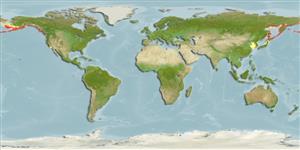>
Perciformes/Zoarcoidei (Eelpouts and pricklebacks) >
Stichaeidae (Pricklebacks) > Alectriinae
Etymology: Alectrias: Greek, alektros, -os, -on = single, married in illegal or unhappy marriage (Ref. 45335).
More on author: Pallas.
Environment: milieu / climate zone / rango de profundidad / distribution range
Ecología
marino demersal; rango de profundidad 0 - 100 m (Ref. 50550), usually ? - 50 m (Ref. 51666). Temperate
Northwest Pacific: Commander Islands and southeastern Kamchatka to the Sea of Okhotsk and northern Sea of Japan. Northeast Pacific: Alaska.
Tamaño / Peso / Age
Madurez: Lm ? range ? - ? cm
Max length : 10.0 cm SL macho / no sexado; (Ref. 43239)
Short description
Claves de identificación | Morfología | Morfometría
Espinas dorsales (total) : 59 - 66; Radios blandos dorsales (total) : 0; Espinas anales: 1; Radios blandos anales: 41 - 45; Vértebra: 64 - 70. Gray to nearly black to bright spotted with patterns; usually a wavy line extending along back, separating dark portion from lighter spots that continue onto dorsal fin (Ref. 43939). Caudal fin rounded.
Mainly intertidal, but may be found at depths as much as 100 m (Ref. 43939); typically found shallower than 50 meters (Ref. 51666). Often in bays with pebble-rock debris bottoms (Ref. 43939). Oviparous, eggs are guarded by the female parent (Ref. 58332).
Life cycle and mating behavior
Madurez | Reproducción | Puesta | Huevos | Fecundidad | Larva
Mecklenburg, C.W., T.A. Mecklenburg and L.K. Thorsteinson, 2002. Fishes of Alaska. American Fisheries Society, Bethesda, Maryland. xxxvii +1037 p. (Ref. 43939)
IUCN Red List Status (Ref. 130435: Version 2024-2)
Threat to humans
Harmless
Human uses
Herramientas
Special reports
Download XML
Fuentes de Internet
Estimates based on models
Preferred temperature (Referencia
123201): 2.3 - 12.9, mean 6 °C (based on 248 cells).
Phylogenetic diversity index (Referencia
82804): PD
50 = 0.5156 [Uniqueness, from 0.5 = low to 2.0 = high].
Bayesian length-weight: a=0.01000 (0.00244 - 0.04107), b=3.04 (2.81 - 3.27), in cm total length, based on all LWR estimates for this body shape (Ref.
93245).
Nivel trófico (Referencia
69278): 3.1 ±0.44 se; based on food items.
Resiliencia (Referencia
120179): Medio, población duplicada en un tiempo mínimo de 1.4-4.4 años (Preliminary K or Fecundity.).
Fishing Vulnerability (Ref.
59153): Low vulnerability (10 of 100).
🛈
